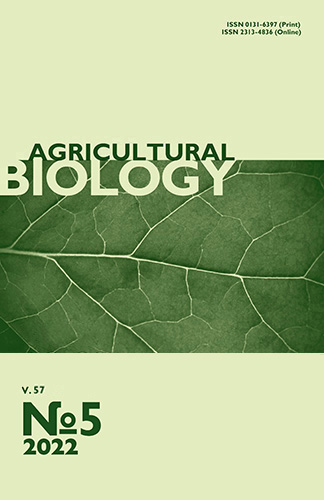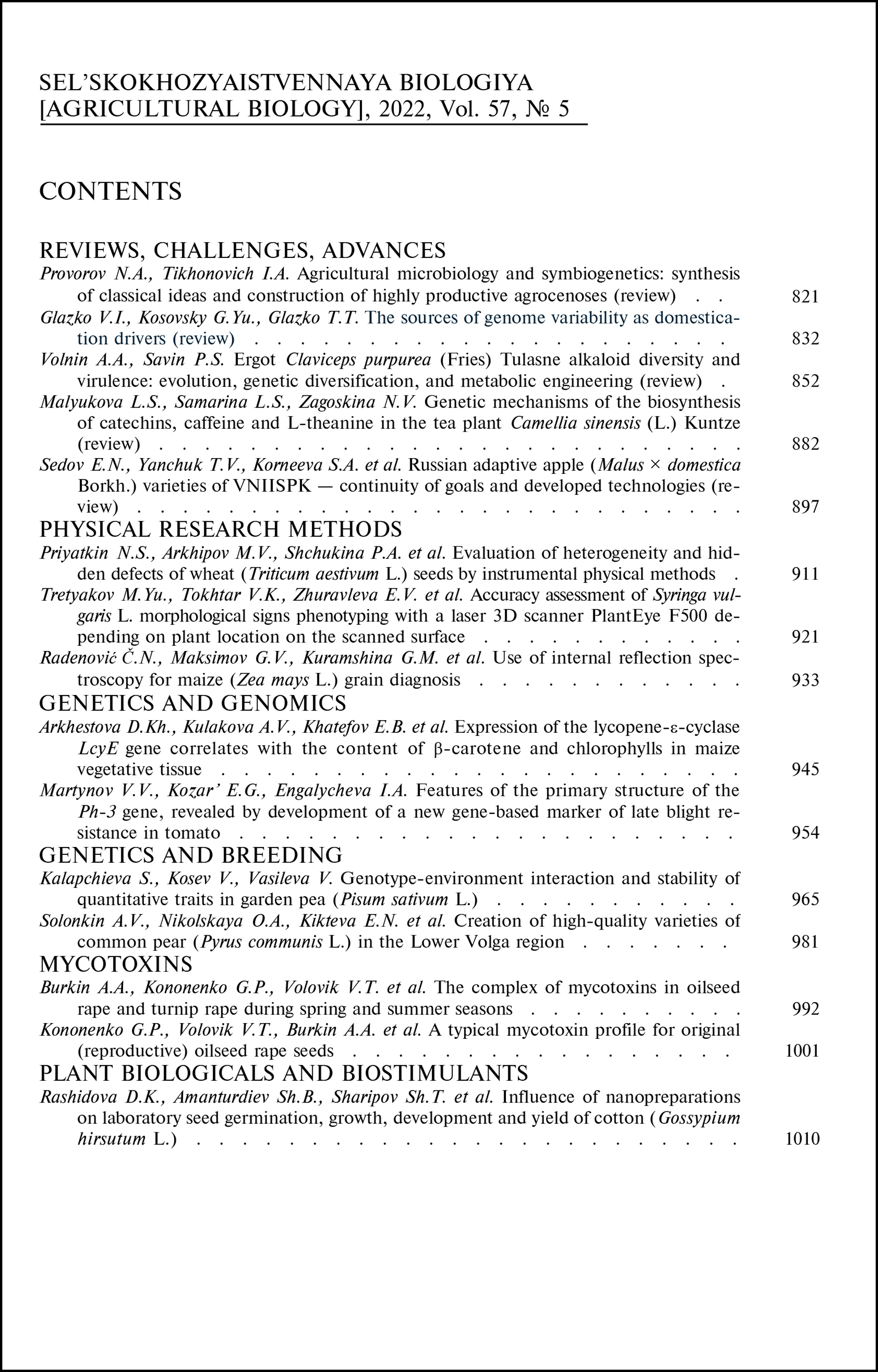doi: 10.15389/agrobiology.2022.5.981eng
UDC: 634.13:631.527
Acknowledgements:
The work was carried out within the framework of state task No. 122020100448-6 “Creation of new competitive forms, varieties and hybrids of cultivated, woody and shrubby plants with high productivity, quality and increased resistance to adverse environmental factors, new innovative technologies in seed production and nursery with taking into account varietal characteristics and soil-climatic conditions of arid territories of the Russian Federation”.
CREATION OF HIGH-QUALITY VARIETIES OF COMMON PEAR (Pyrus communis L.) IN THE LOWER VOLGA REGION
А.V. Solonkin, O.A. Nikolskaya, E.N. Kikteva, E.V. Seminchenko✉
Federal Scientific Center of Agroecology, Complex Melioration and Protective Afforestation RAS, 97 Universitetskiy Pros-pekt, Volgograd, 400062 Russia, e-mail solonkin-a@vfanc.ru, lelka-nikolskaya@mail.ru, aristokratka12@yandex.ru, eseminchenko@mail.ru (✉ corresponding author)
ORCID:
Solonkin А.V. orcid.org/0000-0002-1576-7824
Kikteva E.N. orcid.org/0000-0002-3095-2884
Nikolskaya O.A. orcid.org/0000-0002-1337-7101
Seminchenko E.V. orcid.org/0000-0003-3155-9563
Received June 22, 2022
Nowadays, the creation of high-quality pear varieties of different ripening behavior with early-, mid-, and late-season maturing is still relevant goal for breeders of the Lower Volga region. The long-term pome fruit breeding program, including pear breeding, is carried out in the Laboratory of breeding, seed production and nursery of the Federal Scientific Center for Agroecology, Land Reclamation and Protective Afforestation RAS. The parent forms involved in intervarietal and interspecific hybridization and targeted selection are mainly European varieties of high quality but low resistance to adverse climatic factors and local varieties of high resistance but poor fruit quality. As a result, new pears varieties were released, e.g., Dubovskaya rannyayya, Zimnyaya kubarevidnaya, Yubiley Korneeva, Nadazhda, Andreevskaya, Doktosxaya, Ordinata, Lavanda, Omega, Pamyat’ Korneeva, Kapella, Raketa, Positivnaya, Fermata, Banketnaya, Versiya, Nectarnaya, etc. Fully ripened fruits were collected in certain parts of the tree (early-ripening varieties) or at storage sites (late-ripening varieties) to determine quality parameters. Fruits were weighed on a laboratory scale and measured with a ruler to determine the average and maximum fruit weigh and size. Fruit appearance was assessed visually on a five-point scor, taste — by tastings carried out as the fruit ripened, on a five-point scor. The juice concentration of soluble solids was determined refractometrically. The total acidity was assessed by titration of an aqueous extract with 0.1 N alkali solution, sugar content (sum of sugars, mono-, disaccharides) was estimated by Bertrand’s method, pectin by carbazole method based on the interaction of carbazole with D-galacturonic acid, the vitamin C content by titration of oxalate extracts with Tillman’s reagent (2,6-dichlorophenolindophenol). It was established that the largest fruits (250 g and more) were formed by the varieties Pamyat’ Korneeva, Pozitivnaya, Kapella and Banketnaya. Since this trait is inherited from the parental large-fruited Olivier de Serre and Bakhmal cultivars, the new varieties, in addition to high commercial attractiveness, can be successfully used as sources in the creation of new large-fruited pear varieties of different ripening terms. The varieties Pamyat’ Korneeva, Nektar, and Fermata with excellent dessert balanced taste (4.7-5 points) and attractive fruit appearance surpass standard varieties in these traits. The genetic sources of the high taste quality of these varieties were the ancestral cultivars Alexandrine Dulyar and Bere Gardi with an exquisite taste and pleasant aroma. These genotypes can also be involved in future breeding for exquisite taste and commercial quality of fruits. The content of sugars in the fruits varied from 8.9 to 15.5 %, with the highest amount for the varieties Doktorskaya (15.48 %), Fermata (14.03 %), Versiya (16.3 %), and Kapella (15.5 %). These varieties also had the most balanced taste due to the low acid content. Biochemical composition, in addition to taste and quality, determines fruit suitability for processing and as an improver of finished (processed) products. For these purposes, the varieties Ordinate, Raketa, Kapella, Versiya, and Fermata and the most suitable. Therefore, of the released pear varieties, the varieties Pamyat’ Korneeva and Kapella outstand due to a complex of economically valuable features and are suitable not only for commercial production but also for further breeding program.
Keywords: Pyrus communis L., pear, fruits quality, biochemical composition, breeding, new varieties.
REFERENCES
- Goldschmidt E.E. The evolution of fruit tree productivity: a review. Econ Bot, 2013, 67: 51-62 CrossRef
- Kiseleva N.S. Subtropicheskoe i dekorativnoe sadovodstvo, 2015, 52: 41-48 (in Russ.).
- Bandurko I.A. Materialy Mezhdunarodnoy nauchno-metodicheskoi konferentsii «Sostoyanie sortimenta plodovykh i yagodnykh kul’tur i zadachi selektsii» [Proc. Int. Conf. «The assortment of fruit and berry crops and the tasks of selection»]. Orel, 1996, 19-21 (in Russ.).
- Sedov E.N., Dolmatov E.A. Selektsiya grushi [Pear breeding]. Orel, VNIISPK, 1997 (in Russ.).
- Ozherelieva Z., Sedov E. Low temperature tolerance of apple cultivars of different ploid at different times of tne winter. Proceedings of the Latvian Academy of Sciences, Section B: Natural, Exact, and Applied Sciences, 2017, 71(3): 127-131 CrossRef
- Leonchenko V.G. Materialy Mezhdunarodnoy nauchno-metodicheskoi konferentsii «Sostoyanie sortimenta plodovykh i yagodnykh kul’tur i zadachi selektsii» [Proc. Int. Conf. «The assortment of fruit and berry crops and the tasks of selection»]. Orel, 1996: 151-153 (in Russ.).
- Galasheva A.M., Sedov E.N., Krasova N.G., Dolmatov E.A., Serova Z.M. Sovremennoe sadovodstvo, 2018, 1(25): 1-9 CrossRef (in Russ.).
- Solonkin A.V., Nikolskaya O.A., Kikteva E.N. Selection improvement of pear (Pyrus communis L.) in the lower Volga region. IOP Conference Series: Earth and Environmental Science, 548(8): 082048 CrossRef
- Solonkin A.V., Nikol’skaya O.A., Kikteva E.N. Izvestiya Nizhnevolzhskogo agrouniversitetskogo kompleksa: Nauka i vysshee professional’noe obrazovanie, 2021, 1(61): 103-112 CrossRef (in Russ.).
- Miller A.J., Gross B.L. From forest to field: perennial fruit crop domestication. Am. J. Bot.,2011, 98(9): 1389-1414 CrossRef
- Iglesias I. Agronomical performance and fruit quality of early harvesting pear cultivars in Spain. Acta Hortic.,2008, 249-256 CrossRef
- Solonkin A.V., Eremin G.V., Dubravina I.V. Politematicheskiy setevoy еlektronnyy nauchnyy zhurnal Kubanskogo gosudarstvennogo agrarnogo universiteta, 2018, 136(02): 146-156 CrossRef (in Russ.).
- Satibalov A.V. Plodovodstvo i vinogradarstvo Yuga Rossii, 2013, 21(3): 15-30 (in Russ.).
- Ferlito F., Di Guardo M., Allegra M., Nicolosi E., Continella A., La Malfa S., Gentile A., Distefano G. Assessment of chilling requirement and threshold temperature of a low chill pear (Pyrus communis L.) germplasm in the Mediterranean Area. Horticulturae, 2021, 7(3): 45 CrossRef
- Li X., Wang T., Zhou B., Gao W., Cao J., Huang L. Chemical composition and antioxidant and anti-inflammatory potential of peels and flesh from 10 different pear varieties (Pyrus spp.). Food Chem.,2014, 152: 531-538 CrossRef
- Konarska A. The relationship between the morphology and structure and the quality of fruits of two pear cultivars (Pyrus communis L.) during their development and maturation. Sci. World J.,2013, 2013: 1-13 CrossRef
- Zhang M.-Y., Xue C., Li J., Xue Y., Wang R., Tao S., Qin M., Bai B., Li X., Gu C., Yang G., Liu Y., Sun M., Zhang S., Wu J., Chen X., Hu H., Fan J., Zou C., Wu S. Genome-wide association studies provide insights into the genetic determination of fruit traits of pear. Nature Communications, 2021, 12(1): 1144 CrossRef
- Semeykina V.M. Materialy Mezhdunarodnoy nauchno-prakticheskoy konferentsii, posvyashchennoy 100-letnemu yubileyu Omskogo GAU «Nauchnye innovatsii — agrarnomu proizvodstvu» [Proc. Int. Conf. «Scientific innovations for agricultural production»]. Omsk, 2018: 917-923 (in Russ.).
- Else M., Atkinson C. Climate change impacts on UK top and soft fruit production. OutlookonAgriculture, 2010, 39(2): 257-262 CrossRef
- Eremin G.V., Dubravina I.V., Kovalenko N.N., Gasanova T.A. Predvaritel’naya selektsiya plodovykh kul’tur: monografiya. 2-e izdanie, pererabotannoe i dopolnennoe /Pod redaktsiey G.V. Eremina [Preliminary selection of fruit crops: monograph. 2nd edition, revised and enlarged. G.V. Eremin (ed.)].Krasnodar, 2016 (in Russ.).
- Eremin G.V., Isachkin A.V., Kazakov I.V. Kuminov E.P., Plekhanova M.N., Sedov E.N. Obshchaya i chastnaya selektsiya i sortovedenie plodovykh i yagodnykh kul’tur [General and specific breeding and cultivars of fruit and berry crops]. Moscow, 2004 (in Russ.).
- Zhang M.-Y., Xue C., Hu H., Li J., Xue Y., Wang R., Fan J., Zou C., Tao S., Qin M., Bai B., Li X., Gu C., Wu S., Chen X., Yang G., Liu Y., Sun M., Fei Z., Zhang S., Wu J. Genome-wide association studies provide insights into the genetic determination of fruit traits of pear. Nature Communications, 2021, 12: 1144 CrossRef
- Eremina O., Eremin V., Smirnov R. Genealogical analysis of large-fruited sweet cherry varieties in accordance with the s-locus of parental forms, and the pattern of inheritance of large-fruited in the presence of s5 and s9 alleles in the genome. BIO Web of Conferences, 2020: 03005 CrossRef
- Nybom H., Lācis G. Recent large-scale genotyping and phenotyping of plant genetic resources of vegetatively propagated crops. Plants, 2021, 10(2): 415 CrossRef
- Fazliakhmetov Kh.N., Zaripova V.M. Izvestiya Nizhnevolzhskogo agrouniversitetskogo kompleksa: Nauka i vysshee professional’noe obrazovanie, 2020, 4(60): 210-217 CrossRef (in Russ.).
- Michailidis M., Karagiannis E., Nasiopoulou E., Skodra C., Molassiotis A., Tanou G. Peach, apple, and pear fruit quality: to peel or not to peel? Horticulturae, 2021, 7(4): 85 CrossRef
- Egorov E.A., Eremin G.V., Suprun I.I., Shcheglov S.N., Dragavtseva I.A., Dubravina I.V., Permyakova S.V., Artyukh S.N., Ul’yanovskaya E.V., Kovaleva V.V., Medvedeva N.I., Buntsevich L.L., Zaremuk R.Sh., Kuznetsova A.P., Yakuba Yu.F., Nen’ko N.I., Doroshenko T.N., Gasanova T.A., Kiseleva G.K., Mokhno V.S., Prichko T.G., Chalaya L.D., Lugovskoy A.P., Efimova I.L., Mozhar N.V., Kiseleva G.N., Ermolenko V.G., Alekhina E.M., Dolya Yu.A., Eremina O.V., Eremin V.G., Sukhorukikh Yu.I., Makhno V.G., Yakovenko V.V., Lapshin V.I., Podorozhnyy V.N., Kulyan R.V., Tokarev A.P., Tuov M.T., Ayba L.Ya., Tyshchenko E.L., Timkina Yu.V., Bratukhina E.V., Lobova T.E., Kozina S.V., Evsyukova T.V., Slepchenko N.A., Petrov V.S., Il’nitskaya E.T., Nud’ga T.A., Sundyreva M.A., Talash A.I., Zhukov A.I., Serpukhovitina K.A., Nosul’chak V.A., Il’yashenko O.M., Bol’shakov V.A., Il’ina I.A., Guguchkina T.I., Yakimenko E.N., Antonenko O.P., Reznichenko K.V., Bandurko I.A. Sovremennye metodologicheskie aspekty organizatsii selektsionnogo protsessa v sadovodstve i vinogradarstve [Modern methodological aspects of the organization of the breeding process in horticulture and viticulture]. Krasnodar, 2012 (in Russ.).
- Programma i metodika sortoizucheniya plodovykh, yagodnykh i orekhoplodnykh /Pod redaktsiey E.N. Sedova, T.P. Ogol’tsovoy [Program and methodology for the study of fruit, berry and nut varieties. E.N. Sedov, T.P. Ogol’tsova (eds.)]. Orel, 1999 (in Russ.).
- Mozhar N.V. Phenotypic assessment of pear varieties in mutual pollination. BIO Web of Conferences, 2021: 01012 CrossRef
- Wu J., Wang Y., Xu J., Korban S.S., Fei Z., Tao S., Ming R., Tai S., Khan A.M., Postman J.D., Gu C., Yin H., Zheng D., Qi K., Li Y., Wang R., Deng C.H., Kumar S., Chagné D., Li X., Wu J., Huang X., Zhang H., Xie Z., Li X., Zhang M., Li Y., Yue Z., Fang X., Li J., Li L., Jin C., Qin M., Zhang J., Wu X., Ke Y., Wang J., Yang H., Zhang S. Diversification and independent domestication of Asian and European pears. Genome Biology, 2018, 19: 77 CrossRef
- Rezviakova S., Gurin A., Revin N. Distinct features of adaptive and productive potential of prospective pear varieties. E3S Web of Conferences, 2020, 161: 01055 CrossRef
- Telezhinskiy D.D. V sbornike: Sostoyanie i perspektivy razvitiya severnogo sadovodstva. Sbornik nauchnykh trudov [In: State of art and prospects for the development of northern horticulture. Collection of scientific papers]. Ekaterinburg, 2016, 118-123 (in Russ.).
- Shirasawa K., Isuzugawa K., Ikenaga M., Saito Y., Yamamoto T., Hirakawa H., Isobe S. The genome sequence of sweet cherry (Prunus avium) for use in genomics-assisted breeding. DNA Research, 2017, 24(5): 499-508 CrossRef
- Meland M., Maas F.M., Jørgensen Å. Sweet cherry production in controlled environment. Acta Hortic., 2019, 1235: 353-358 CrossRef
- Wang R., Xue Y., Fan J., Yao J., Qin M., Lin T., Lian Q., Zhang M., Li X., Li J., Sun M., Song B., Zhang J., Zhao K., Chen X., Hu H., Fei Z., Xue C., Wu J. A systems genetics approach reveals PbrNSC as a regulator of lignin and cellulose biosynthesis in stone cells of pear fruit. Genome Biol.,2021, 22: 313 CrossRef












